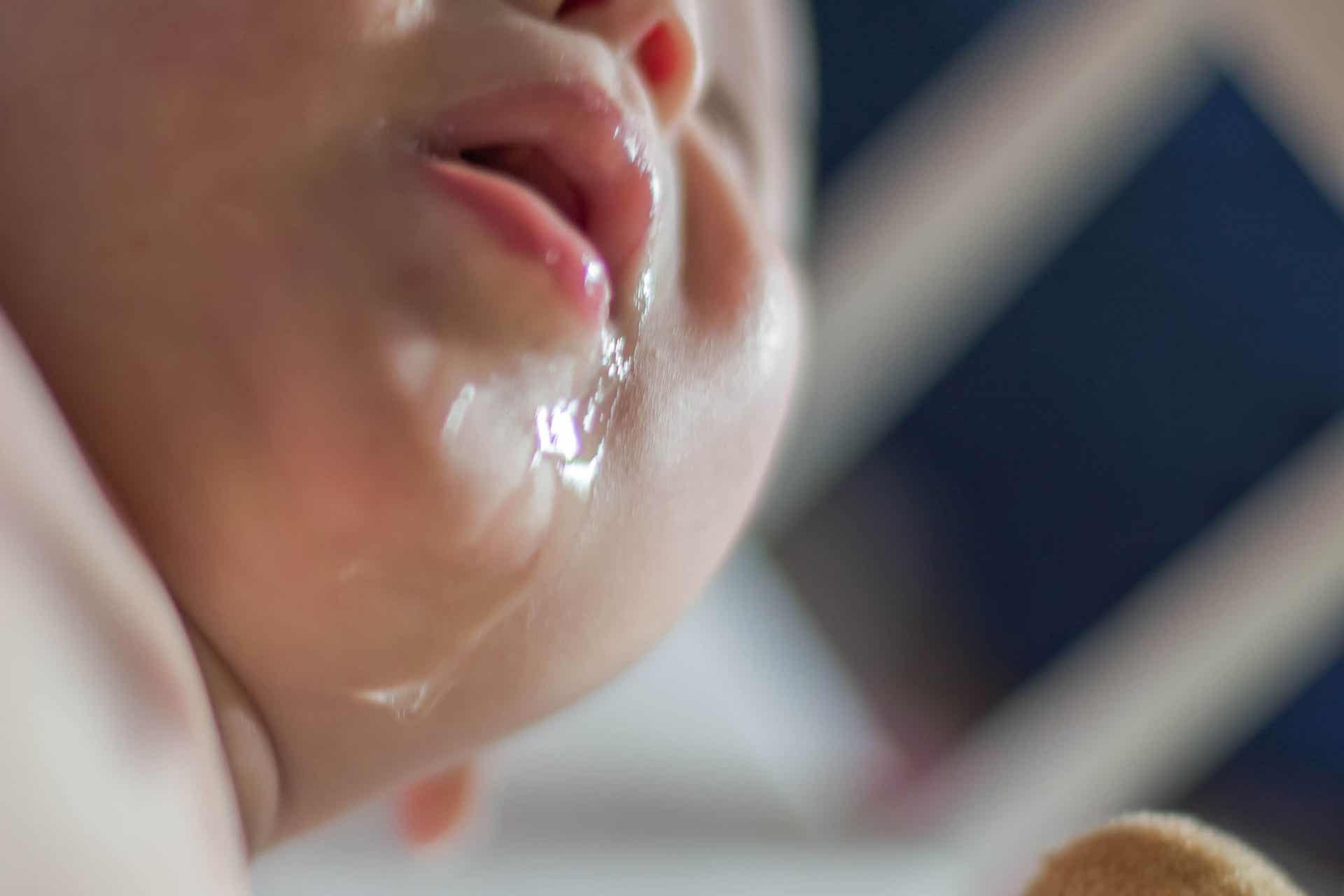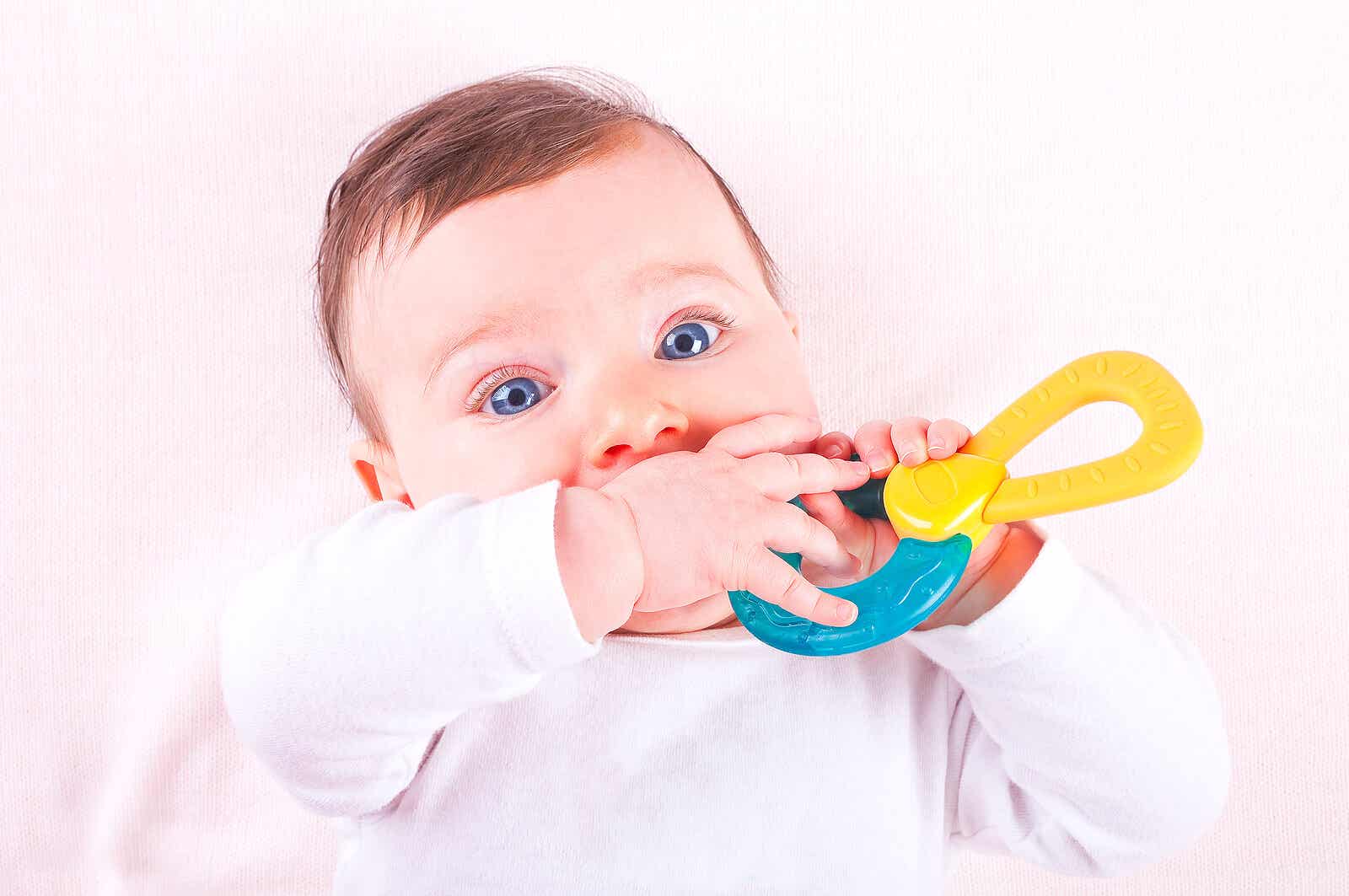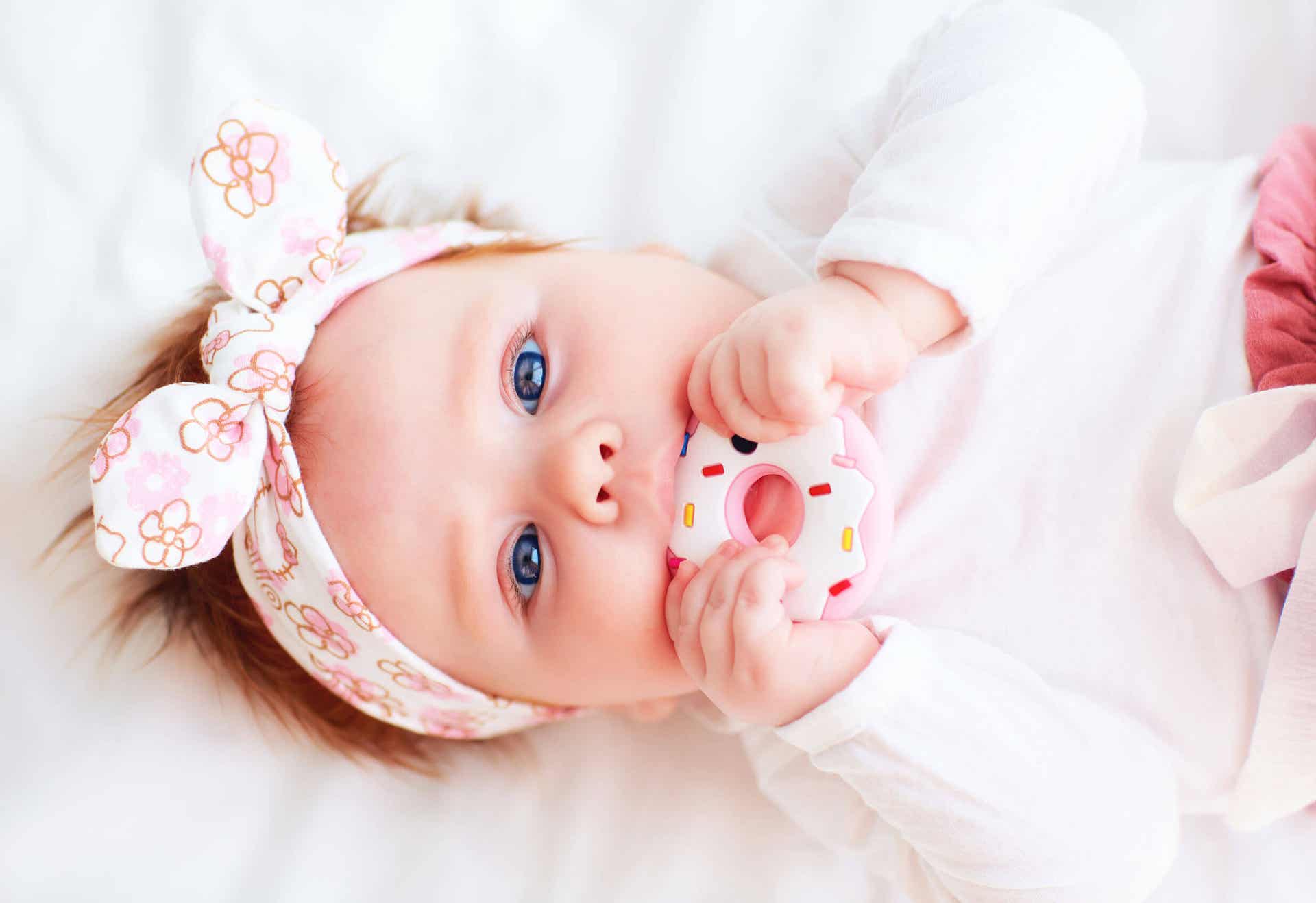Pain Relief for Teething Babies
When babies start teething, parents’ main concern is to alleviate their teeth and gum pain. Besides, the babies’ drooling, annoyance, and irritability complete this unpleasant experience. This is why, today, we’ll talk about pain relief for teething babies.
Luckily, certain practices can make this period more bearable. Next, we’ll tell you about the most common symptoms when babies start teething. We’ll also talk about what parents can do to alleviate gum pain, and how to take good care of the new and emerging teeth.
Teething babies and their symptoms
The moment teeth start emerging varies depending on each baby. However, it usually happens when they’re about six months old. Lower incisors are usually the first primary teeth to appear, and then, the upper incisors follow.
When teeth are about to emerge, they put pressure on the gums to make them thinner, in order to break through them. As a result, the gum tissue becomes more sensitive and painful. Before or during the process of teething, children may present the following symptoms:

- Drooling.
- Irritability, crying, and bad temper.
- The need to bite and chew things. Babies will put anything in their mouths.
- Problems with falling asleep and sleeping through the night.
- Loss of appetite and annoyance when eating.
- Slight increase in body temperature, but no fever. If the baby has a fever, you have to visit the pediatrician, because teething doesn’t cause a temperature higher than 99.86 ºF.
These symptoms tend to disappear once the tooth emerges, or a few days later.
Tips to alleviate teeth and gum pain in teething babies
If the baby is irritated when teeth start erupting, there are some simple techniques you can put into practice to alleviate their teeth and gum pain.
Massage and stimulate their gums
In order to relieve the gum pain in the baby, put pressure on their gum tissue. You can use your clean fingers and knuckles, gauze or silicone rubber brushes to massage their gums.
In addition, you can give them plastic, rubber or silicone teethers, which are specially designed to help them cope with the pain. Besides, if you put them in the fridge for a while, they’ll be even more helpful.
If your baby is already eating solid food, you can use such food to massage their gum tissue and relieve your baby’s pain. Carrots, toasts, fruits or cold bread are some examples of the solid food babies can bite to massage their gums. Remember to do this under supervision to prevent your baby from choking.
Teething babies: apply cold treatment
Applying cold on the gum tissue acts as anti-inflammatory and eases teeth and gum pain. You can give them cold teethers, spoons or wet towels.
When children are eating solid foods, you can give them cold fruits. For example, bananas are healthy and fresh snacks.
In order to prevent babies from choking, you can use fruit teethers. However, it’s helpful to pay close attention to your babies when you give them something to alleviate their pain.
Remember to chill everything in the fridge and not in the freezer. This is because extremely cold temperatures can damage the baby’s gums.
Give them medicine
You can give over-the-counter anti-inflammatory medicine to relieve your baby’s gum pain. However, you should always ask the pediatrician or pediatric dentist for advice, before giving any kind of medicine.
Furthermore, there are topical analgesic medications you can put on the baby’s gum tissue. They act as anti-inflammatory and anesthetic, but specialists don’t recommend them.
This is because, since babies drool, this type of medicine doesn’t last long in the mouth. Besides, they can swallow it and anesthetize the baby’s throat, making it difficult for babies to swallow.
As we’ve previously mentioned, before using any medication, talk to the doctor first. Besides, it’ll be better to go through this process without the use of any kind of medicine.

Routines and loving moments
Try to maintain your baby’s rest and hygiene habits. If you change their habits because of their mood swings, it might be difficult to resume their old habits.
Your arms and displays of love are the best medicine your baby can have. So, take your time to calm them down, entertain and comfort them. By doing this, you’ll distract them and they’ll feel relieved.
Avoid the following products when your baby is teething
Sometimes, people recommend certain products to alleviate baby’s gum pain, but you should try to avoid them. The following are some examples of these:
- Medication: you should only use over-the-counter medication, topical gels and homeopathic pills if the specialist recommends them.
- Home remedies: specialists don’t recommend the use of home remedies prepared with certain herbs, such as chamomile or ginger.
- Teething bracelets, necklaces and ankle braces: these come in amber, marble, wood or silicone. Even though they’ve become quite popular, their effectiveness hasn’t been proved. Furthermore, babies may run the risk of choking or suffocating when using them. Actually, the US Food and Drug Administration (FDA) advises people against their use.
How should you take care of your baby’s new teeth?
If you take good care of your baby’s oral hygiene from an early age, you’ll avoid future problems. In order to do this, you should clean your baby’s gums from the beginning. You can clean them using a cloth or gauze, twice a day. This way, you’ll eliminate food residue and bacteria.

When the first teeth emerge, it’s time to start using soft toothbrushes. You can use small amounts of fluoride toothpaste, or you can wait until they learn to spit, which usually occurs when they’re three years old. A dentist will advise you about this and the risk of cavities.
You should visit a pediatric dentist before your baby’s first birthday. A professional will help you take care of your baby’s oral health.
You can alleviate your baby’s gum pain at home
Teething can be quite a difficult situations for babies and parents. Besides, this is a new experience for babies and they need to explore this process.
Be with them and go through this experience in the most natural and loving way. You can put into practice some of our useful tips. They’re simple, practical and you can do it at home.
When babies start teething, parents’ main concern is to alleviate their teeth and gum pain. Besides, the babies’ drooling, annoyance, and irritability complete this unpleasant experience. This is why, today, we’ll talk about pain relief for teething babies.
Luckily, certain practices can make this period more bearable. Next, we’ll tell you about the most common symptoms when babies start teething. We’ll also talk about what parents can do to alleviate gum pain, and how to take good care of the new and emerging teeth.
Teething babies and their symptoms
The moment teeth start emerging varies depending on each baby. However, it usually happens when they’re about six months old. Lower incisors are usually the first primary teeth to appear, and then, the upper incisors follow.
When teeth are about to emerge, they put pressure on the gums to make them thinner, in order to break through them. As a result, the gum tissue becomes more sensitive and painful. Before or during the process of teething, children may present the following symptoms:

- Drooling.
- Irritability, crying, and bad temper.
- The need to bite and chew things. Babies will put anything in their mouths.
- Problems with falling asleep and sleeping through the night.
- Loss of appetite and annoyance when eating.
- Slight increase in body temperature, but no fever. If the baby has a fever, you have to visit the pediatrician, because teething doesn’t cause a temperature higher than 99.86 ºF.
These symptoms tend to disappear once the tooth emerges, or a few days later.
Tips to alleviate teeth and gum pain in teething babies
If the baby is irritated when teeth start erupting, there are some simple techniques you can put into practice to alleviate their teeth and gum pain.
Massage and stimulate their gums
In order to relieve the gum pain in the baby, put pressure on their gum tissue. You can use your clean fingers and knuckles, gauze or silicone rubber brushes to massage their gums.
In addition, you can give them plastic, rubber or silicone teethers, which are specially designed to help them cope with the pain. Besides, if you put them in the fridge for a while, they’ll be even more helpful.
If your baby is already eating solid food, you can use such food to massage their gum tissue and relieve your baby’s pain. Carrots, toasts, fruits or cold bread are some examples of the solid food babies can bite to massage their gums. Remember to do this under supervision to prevent your baby from choking.
Teething babies: apply cold treatment
Applying cold on the gum tissue acts as anti-inflammatory and eases teeth and gum pain. You can give them cold teethers, spoons or wet towels.
When children are eating solid foods, you can give them cold fruits. For example, bananas are healthy and fresh snacks.
In order to prevent babies from choking, you can use fruit teethers. However, it’s helpful to pay close attention to your babies when you give them something to alleviate their pain.
Remember to chill everything in the fridge and not in the freezer. This is because extremely cold temperatures can damage the baby’s gums.
Give them medicine
You can give over-the-counter anti-inflammatory medicine to relieve your baby’s gum pain. However, you should always ask the pediatrician or pediatric dentist for advice, before giving any kind of medicine.
Furthermore, there are topical analgesic medications you can put on the baby’s gum tissue. They act as anti-inflammatory and anesthetic, but specialists don’t recommend them.
This is because, since babies drool, this type of medicine doesn’t last long in the mouth. Besides, they can swallow it and anesthetize the baby’s throat, making it difficult for babies to swallow.
As we’ve previously mentioned, before using any medication, talk to the doctor first. Besides, it’ll be better to go through this process without the use of any kind of medicine.

Routines and loving moments
Try to maintain your baby’s rest and hygiene habits. If you change their habits because of their mood swings, it might be difficult to resume their old habits.
Your arms and displays of love are the best medicine your baby can have. So, take your time to calm them down, entertain and comfort them. By doing this, you’ll distract them and they’ll feel relieved.
Avoid the following products when your baby is teething
Sometimes, people recommend certain products to alleviate baby’s gum pain, but you should try to avoid them. The following are some examples of these:
- Medication: you should only use over-the-counter medication, topical gels and homeopathic pills if the specialist recommends them.
- Home remedies: specialists don’t recommend the use of home remedies prepared with certain herbs, such as chamomile or ginger.
- Teething bracelets, necklaces and ankle braces: these come in amber, marble, wood or silicone. Even though they’ve become quite popular, their effectiveness hasn’t been proved. Furthermore, babies may run the risk of choking or suffocating when using them. Actually, the US Food and Drug Administration (FDA) advises people against their use.
How should you take care of your baby’s new teeth?
If you take good care of your baby’s oral hygiene from an early age, you’ll avoid future problems. In order to do this, you should clean your baby’s gums from the beginning. You can clean them using a cloth or gauze, twice a day. This way, you’ll eliminate food residue and bacteria.

When the first teeth emerge, it’s time to start using soft toothbrushes. You can use small amounts of fluoride toothpaste, or you can wait until they learn to spit, which usually occurs when they’re three years old. A dentist will advise you about this and the risk of cavities.
You should visit a pediatric dentist before your baby’s first birthday. A professional will help you take care of your baby’s oral health.
You can alleviate your baby’s gum pain at home
Teething can be quite a difficult situations for babies and parents. Besides, this is a new experience for babies and they need to explore this process.
Be with them and go through this experience in the most natural and loving way. You can put into practice some of our useful tips. They’re simple, practical and you can do it at home.
All cited sources were thoroughly reviewed by our team to ensure their quality, reliability, currency, and validity. The bibliography of this article was considered reliable and of academic or scientific accuracy.
- de la Teja Ángeles, Eduardo. “Erupción dentaria.” (2019).
- Carreño, Brenda, et al. “Cronología de la erupción dentaria en un grupo de mestizos caucasoides de Cali (Colombia).” Revista Estomatología 25.1 (2017): 16-22.
- de Holanda Teixeira, Rangel Bastos, Dayse Andrade Romão, and Mariana Alencar Nemezio. “Evaluación de la relación de los signos y síntomas durante el período de erupción de los dientes primarios.” Revista de Odontopediatría Latinoamericana 9.2 (2019): 9-9.
- Ayala Pérez, Yolanda, Leyanis de la Caridad Carralero Zaldívar, and Beatriz del Rosario Leyva Ayala. “La erupción dentaria y sus factores influyentes.” Correo Científico Médico 22.4 (2018): 681-694.
- Azcona, María Susana. “SALUD BUCAL Y COMUNIDADES MAPUCHES: UN ANÁLISIS ETNO-EPIDEMIOLÓGICO.” Cuadernos de Antropología 20: 25-31.
- Cox, Catherine, Neil Petrie, and Katrina F. Hurley. “Infant strangulation from an amber teething necklace.” Canadian journal of emergency medicine 19.5 (2017): 400-403.
- Nissen, Michael D., et al. “Baltic amber teething necklaces: could succinic acid leaching from beads provide anti-inflammatory effects?.” BMC complementary and alternative medicine 19.1 (2019): 1-9.
This text is provided for informational purposes only and does not replace consultation with a professional. If in doubt, consult your specialist.








